Xerocomus Quél.
Recent molecular studies have shown that Xerocomus in its current circumscription is likely an artificial grouping and it is possible that it will be split at some point into smaller genera. Molecular studies also have changed our understanding about the species of xerocomoid boletes showing that morphological features are quite variable in this group. Not only microscopic study is essential for determination, but scanning electron microscope will be often needed in this “genus” as the spore ornamentation is not always seen under ordinary light microscope. Do bear in mind that macroscopic characters, such as colours, cracking cuticle, etc., tend to intergrade between the different species. Note that Boletus impolitus and Boletus depilatus that were shown to be close to Xerocomus subtomentosus and its allies, are here retained in Boletus for practical reasons. The same applies also for Phylloporus pelletieri, placed here in a genus of its own, but being also close to Xerocomus subtomentosus group.
Although large reference list will be found under most of the species, one should always consult Ladurner & Simonini (2003) having in mind that there are some new species (X. chrysonemus, X. marekii, X. silwoodensis) described after this otherwise superior book was printed. Useful keys, covering most of the European xerocomoid boletes (except some southern taxa) are provided by Knudsen & Vesterholt (2008), Hills (2008) and Kibby (2011), the later also featuring an excellent comparison chart.
Fruitbody medium to small sized, boletoid, without veil and ring. Stipe solid, often tapering towards the base. Flesh variously coloured, changing or not when exposed to air. Tubes not separable from each other, instead tearing apart. Pores usually angular.
Xerocomus persicolor Engel, Klofac, H. Grünert & R. Grünert
Description
Cap up to 5 cm, at first hemispherical then convex, apricot to peach coloured, exceptionally yellowish orange or yellow, discolouring with age to ochraceous with pinkish tint, dry, velvety and sometimes cracking. Stipe cylindrical or spindle-shaped, often curved at the base, pale yellow to yellow, at the lower half gradually becoming orange to reddish orange, stipe surface blueing. Flesh yellowish in the cap, yellow in the stipe, orange yellow to apricot in the stipe base (this colour is persistent and remains after drying), blueing mostly in the cap when exposed to air. Tubes lemon yellow, blueing when injured. Pores concolorous with the tubes, blueing when bruised. Smell not distinctive. Taste not distinctive. Spores 11–15 × 4.5–5.5 μm, smooth. Pileipellis (the cap cuticle) a palisadoderm of septate hyphae. Hyphae composed of cylindrical cells.
Habitat. Warm broadleaf woodlands, mycorrhizal with oaks (Quercus) and beech (Fagus).
Distribution. Not yet fully understood, but apparently a southern species. So far known only from Bulgaria, Croatia, Greece, Italy, Spain.
Similarity. Similar and might be confused with Xerocomus armeniacus. Although the flesh in the stipe base is similarly coloured in both species when fresh, this colour after drying is persistent only in X. persicolor. The cap cuticle of X. armeniacus is composed of hyphae with abundant plaques revealed when stained in Congo red. Such plaques are not seen in Xerocomus persicolor. Xerocomus rubellus probably could sometimes resemble X. persicolor, but it has yellowish flesh in the stipe base with more or less developed small orange red dots.
Photographs
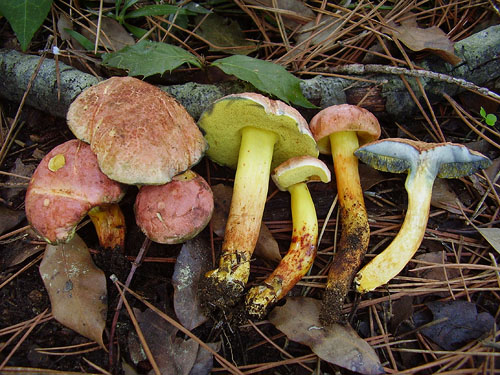
Ample collection of fruitbodies of Xerocomus persicolor. (photo M. Gelardi)
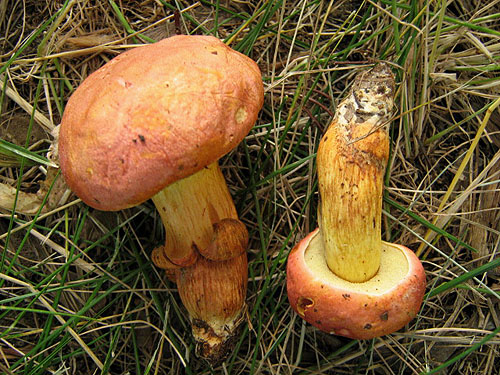
Fruitbodies of Xerocomus persicolor. (photo B. Assyov)
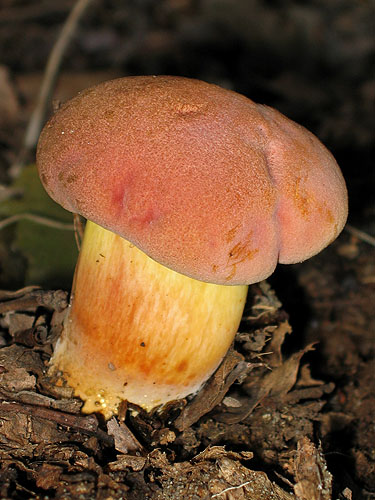
Young fruitbody of Xerocomus persicolor. (photo B. Assyov)
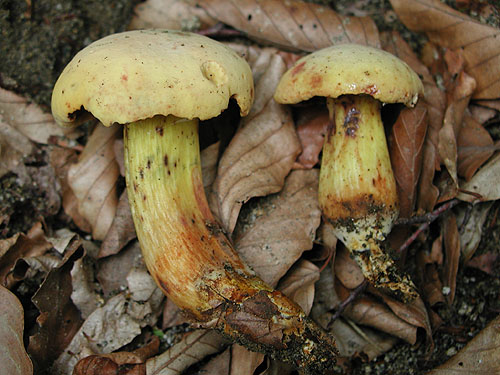
Unusually yellowish coloured fruitbodies of Xerocomus persicolor. (photo B. Assyov)

Old and discoloured fruitbody of Xerocomus persicolor. (photo B. Assyov)
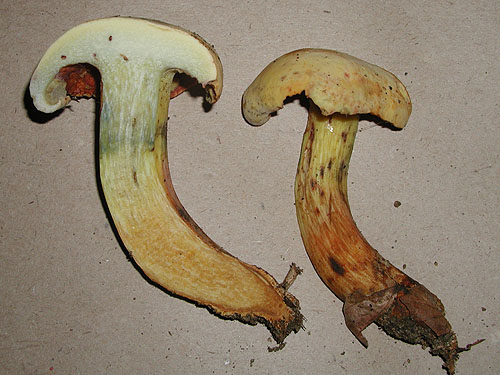
Xerocomus persicolor - colour of the flesh. (photo B. Assyov)
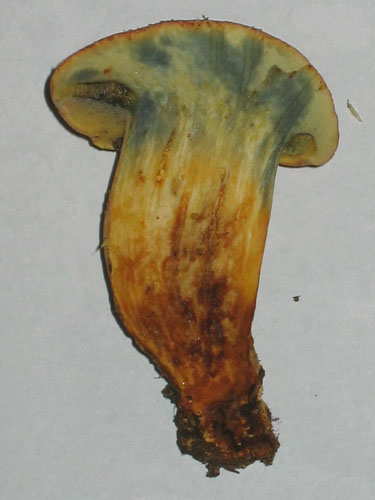
Xerocomus persicolor - colour of the flesh. (photo B. Assyov)
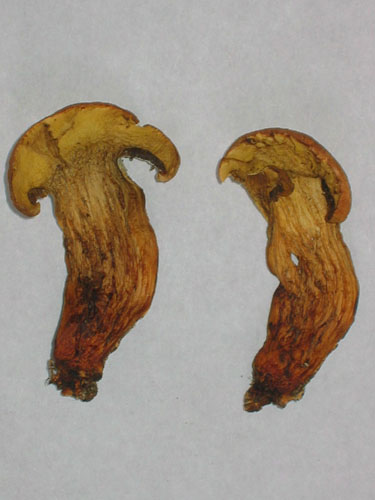
Dried specimen of Xerocomus persicolor. Note the persistent orage colour of the flesh in the lower part of the stipe. (photo B. Assyov)
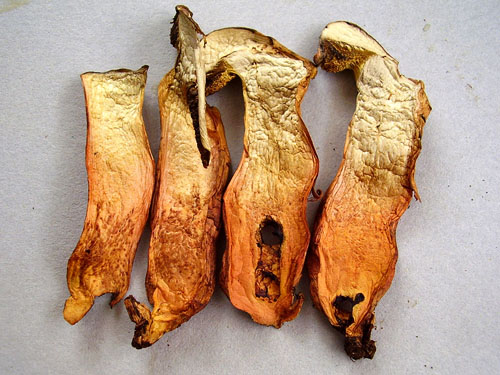
Another set of dried specimens of Xerocomus persicolor. Note again the persistent orange colour in the stipe base. (photo M. Gelardi)
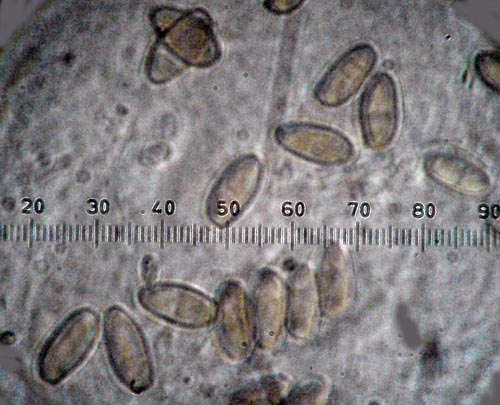
Basidiospores of Xerocomus persicolor. (photo G. Konstantinidis)
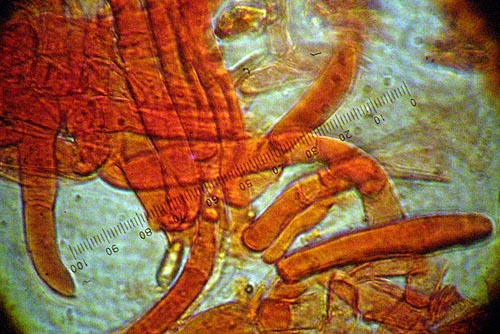
Xerocomus persicolor - pileipellis hyphae in Congo red. (photo G. Konstantinidis)
Important literature
Assyov, B. 2005. New and rare Bulgarian boletes. – Mycologia Balcanica 2: 75–81. (available online)
Engel, H., Dermek, A., Klofac, W., Ludwig, E. & Brückner, T. 1996. Schmier- und Filzröhrlinge s.l. in Europa. Die Gattungen Boletellus, Boletinus, Phylloporus, Suillus, Xerocomus. Verlag Heinz Engel, Weidhausen b. Coburg.
Galli, R. 1998. I Boleti. Atlante pratico-monographico per la determinazione dei boleti. Edinatura, Milano.
Gelardi, M. 2007. Interessanti Boletaceae mediterranee rinvenute nel Lazio: Xerocomus ichnusanus e X. persicolor. – Bolletino del Gruppo Micologico G. Bresadola – Nuova Serie 50(1–3): 141–160.
Hahn, C. 1999. Xerocomus persicolor – ein bemrkenswerter Röhrling aus Griechenland. – Mycologia Bavarica 3: 6-10.
Ladurner, H. & Simonini, G. 2003. Xerocomus s.l. – In: Fungi Europaei. Vol. 8. Pp. 1-527. Edizioni Candusso, Alassio.
Muñoz Sánchez, J.A. & Cadiñanos, J.A. 2001. Algunos Boletales interesantes de la Península Ibérica. – Bellara 17–18: 55–64. (available online)